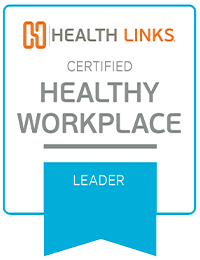
Health Links (HL): Why is the health and wellness of your employees important to you?
Center for Mental Health (CMH): As the majority of an employee’s time is spent in the workplace (which has morphed into longer days, higher stress, constant multi-tasking, etc.) it can be challenging for an employee to think about wellness goals. An on-site wellness program that an employer can provide will allow both the employee and the employer to be more successful in and out of the workplace.
An added benefit to the employer is that healthier employees statistically will have fewer accidents at work and miss fewer days due to illness. And, because most chronic diseases are preventable, healthier employees will help lower the costs of healthcare, which is great for the company’s bottom line in keeping insurance costs down.
Our mission, vision, and value statements are all focused on the health and well-being of those we serve and of the staff members who make up the Center for Mental Health. Being in the field of mental health, we see firsthand the relationship between mental and physical health. Health is holistic. The Center for Mental Health wants those who work here to enjoy good health and wellness to support them in doing very challenging work and have the best chance to maximize their resilience and opportunities for joy. Wellness benefits the whole: the employee – they feel better; their families – they benefit from the example; the organization – productivity and moral are boosted.
HL: What does your workplace wellness program look like?
CMH: We are working with a vendor that provides health risk assessments (HRA), biometric and behavior feedback through a personal tracker, and smartphone apps. These enable staff to participate in group goals and challenges, and set goals and get feedback regarding personal challenges. Employees that enroll in the program and complete the online HRA will also be eligible for up to a $200 wellness reimbursement.
Our organization has worked diligently to create a culture of wellness through training, ongoing internal small group support, support for each staff member, and increasing communication staff wide. People model wellness and come together with other staff with wellness in mind. There is an overall awareness and participation.
HL: How will you/do you know your program is successful?
CMH: The number of participants in the program is a great measure, but more than that is how engaged employees will be with the program (i.e.: are they taking advantage of the challenges and setting personal goals). The other measure will be the statistical information that comes out of the HRA data and developing additional programs to further assist employees with more education and/or programs in the future.
In addition, feedback from appreciative staff, the change in tone in the office, changes in meals brought in to the workplace, open discussions about health and wellness activities, and staff taking advantage of opportunities offered, re: mindfulness, Tai Chi. We also know we are successful when there is less sick leave used or illness prolonged in the work place.
HL: What obstacles did you have to overcome to get your program started? How did you overcome them?
CMH: We’ve had a limited budget, but were always supported by upper management to pursue wellness resources and opportunities for the staff. It has been challenging at times in that we don’t have staff time apportioned to the wellness team: work on wellness endeavors has always been in addition to other full time responsibilities. We’ve overcome such obstacles with dedicated staff, people giving their time above and beyond job duties, and management support for the time we needed. We have worked very hard to ensure that the wellness program was embraced by all of the employees. We have traditionally had more than 80 percent of employees enrolled in the wellness program. Beginning this year, the Center has put a program in place which is now taking wellness to the next level with personal goal setting, a free fitness tracker, and challenges between teams and individuals.
HL: Do you incorporate safety along with your wellness program? If so, what does this look like?
CMH: Safety is not typically addressed through the wellness program. The Center addresses safety through a separate committee that looks at a variety of elements including staff and client safety. The Center addresses safety through online learning, through staff meetings, and through one-on-one coaching opportunities. The Center invites professionals into our buildings to do safety assessments and suggestions. We also now have hired a Facilities Supervisor and part of this individual’s role is to incorporate safety trainings within the organization.
HL: Does your wellness program help give back to your community?
CMH: We have an Employee Club that has a committee that coordinates activities and donations of time/resources to the community. The wellness committee’s initial goal was to develop internal agency wellness then take classes/activities out to the community. The latter has not yet happened, at least not from the wellness program itself. We have, however, invited community participants to workshops that promote wellness and leadership.
HL: What tip/advice would you give to a business that is considering starting a workplace wellness program?
CMH: There is probably a misconception that a wellness program has to cost a lot of money. A company can start with small changes that can make a big impact (such as replacing a snack box with healthier options or removing a soda machine and installing water coolers). Getting employee involvement is key and looking for programs that all employees can be involved in will encourage a higher rate of participation. Also, the great thing about our wellness program is that it is not just about exercise and eating healthy. Of course those things are important, but wellness is much more than that, such as getting enough sleep, reducing stress, financial stability, etc. It is more of a mind-set that we should be focusing on a whole wellness mindset, which is much more than someone’s BMI!
Support and leadership (ideally via modeling) from top management is essential. Input from staff is also essential. With our program, we conducted surveys to ascertain initial areas of interest, willingness/investment in participating, and staffs’ thoughts about meaningful/beneficial activities. It is also important to promote, promote, promote.



